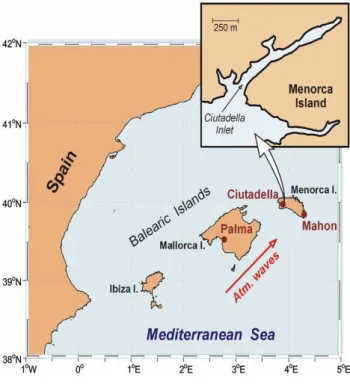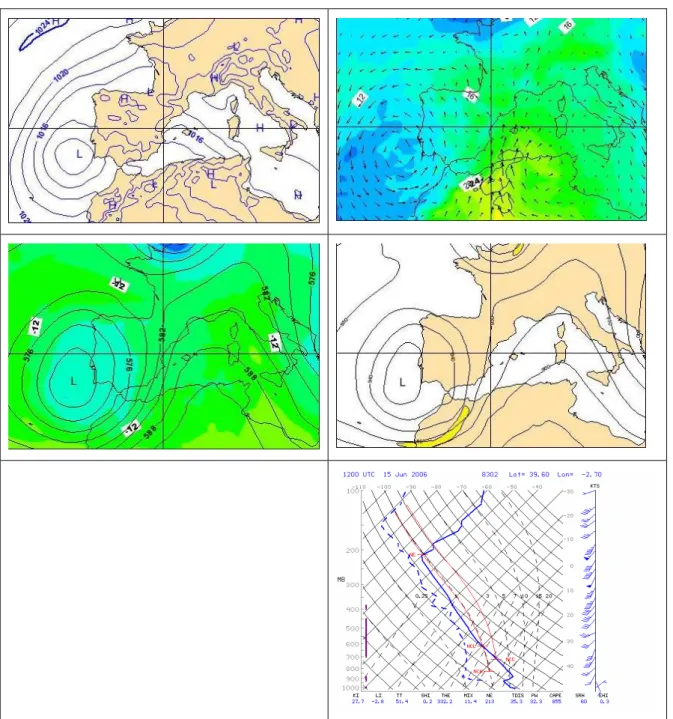HAL Id: hal-00297013
https://hal.archives-ouvertes.fr/hal-00297013
Submitted on 26 Jun 2007
HAL is a multi-disciplinary open access
archive for the deposit and dissemination of
sci-entific research documents, whether they are
pub-lished or not. The documents may come from
teaching and research institutions in France or
abroad, or from public or private research centers.
L’archive ouverte pluridisciplinaire HAL, est
destinée au dépôt et à la diffusion de documents
scientifiques de niveau recherche, publiés ou non,
émanant des établissements d’enseignement et de
recherche français ou étrangers, des laboratoires
publics ou privés.
The rissaga of 15 June 2006 in Ciutadella (Menorca), a
meteorological tsunami
A. Jansa, S. Monserrat, D. Gomis
To cite this version:
A. Jansa, S. Monserrat, D. Gomis. The rissaga of 15 June 2006 in Ciutadella (Menorca), a
meteorolog-ical tsunami. Advances in Geosciences, European Geosciences Union, 2007, 12, pp.1-4. �hal-00297013�
www.adv-geosci.net/12/1/2007/
© Author(s) 2007. This work is licensed under a Creative Commons License.
Geosciences
The rissaga of 15 June 2006 in Ciutadella (Menorca),
a meteorological tsunami
A. Jansa1, S. Monserrat2, and D. Gomis2
1Instituto Nacional de Meteorologia, Palma de Mallorca, Spain
2IMEDEA (University of the Balearic Islands – CSIC), Mallorca, Spain
Received: 6 March 2007 – Revised: 29 April 2007 – Accepted: 16 May 2007 – Published: 26 June 2007
Abstract. An extraordinary “rissaga” event (the local name
for high-amplitude sea level oscillations) with 4–5 m of am-plitude occurred on 15 June 2006 at Ciutadella (Menorca, Spain). In this paper we describe the rissaga event and pro-pose that the meteorological mechanism responsible for it was an unusual pressure jump, associated with a convective squall line.
1 Introduction
“Rissaga” is the local name for sea level oscillations char-acterized by their large amplitude (1 m, in usual cases) and short period (around 10 min) observed in Ciutadella harbour. Simultaneously to the occurrence of rissaga events in Ciu-tadella, sea level oscillations are also observed in other inlets of the Balearic Islands (Spain; see geographical details in Fig. 1) and even in the Mediterranean shores of the Iberian Peninsula, but with smaller amplitudes. Rissaga events typi-cally occur several times a year (mainly in summer) and they usually produce only minor problems to the harbour func-tionality.
A rissaga event is very similar to a tsunami: there are one or two large sea level oscillations, but they are accompanied, before and after, by smaller amplitude oscillations. The to-tal duration of a event can range between a few hours and a couple of days. The event of 15 June 2006 was not recorded, since no tide gauge was deployed at Ciutadella at the time. However, previous events have been recorded and described in previous works (see Fig. 2 as an example). The difference between a rissaga and a tsunami is basically the ultimate ori-gin of the oscillations: tsunamis are generated by a subma-rine earthquake, while rissagas have a meteorological origin (Monserrat et al., 2006).
Correspondence to: A. Jansa (jansa@inm.es)
In order to understand the generation mechanism of a ris-saga, the concept of “seiche” must be first introduced. Every port, bay or inlet has a natural oscillation mode or seiche with a period determined by the physical characteristics of the wa-ter body. The natural seiche of Ciutadella inlet has a period of 10.5 min (according to analytical models and from direct measurements). Natural seiches usually have very small am-plitude (of the order of a few cm at most) and can hardly be visually detected. They appear when the body water oscil-lates around the equilibrium after some small perturbation. However, sometimes they can reach large amplitudes when they are amplified due to resonance with an external exciter. It is in these cases that the resulting sea level oscillations are referred as a “rissaga” event.
The rissaga is thought to be ultimately forced by some kind of meteorological disturbance resulting in rapid sea-level pressure oscillations. These oscillations can be due to atmospheric gravity waves (Ramis and Jansa, 1983; Mon-serrat et al., 1991a, b) and/or to convective pressure jumps (Jansa, 1986). In any case, the atmospheric pressure oscilla-tions generate long surface waves in the ocean which in turn produce an amplified “seiche” whitin the inlet (Tintor´e et al., 1988; Gomis et al., 1993; Garcies et al., 1996).
The general synoptic pattern associated with a rissaga is characterised by (1) low level Mediterranean air, with a weak surface depression, (2) warmer African air blowing above, around 850 hPa, with an inversion layer separating (1) and (2); and (3) a poorly stable or even a conditionally unstable layer between the African air and colder air in the upper lev-els, with a marked vertical wind shear across this layer (usu-ally with strong south-westerly wind blowing at upper lev-els). The described pattern was reported in detail by Ramis and Jansa (1983). Gravity waves (and/or convection) appear in the layer (3) and the vertical oscillations are transmitted to the inversion layer, resulting in pressure oscillations at sur-face (Ramis and Jansa, 1983; Monserrat et al., 1991a, b). These surface atmospheric pressure oscillations induce small
2 A. Jansa et al.: The rissaga of 15 June 2006 in Ciutadella (Menorca)
Fig. 1. Geographical details (see text).
Fig. 2. Mareographic register of rissagas: around 21 h, on 30 July
1998, and around 09 h, on the 31st; the second is the most impor-tant, around 2 m of total amplitude (obtained by experimental in-struments of the University of the Balearic Islands).
amplitude long marine waves that are amplified by several mechanisms, the last one being the resonance with the seiche of the port (Tintor´e at al., 1988; Alonso et al., 1989; Gomis et al., 1989).
Note that the general weather situation that favours the ris-saga is quite similar to the kind of situation that produces heavy rain and severe weather in the Western Mediterranean in general and in the Balearics in particular. The main dif-ference is the thermal inversion: warmer African air flow-ing above colder Mediterranean air. The thermal inversion prevents the mixing of the low layer humid Mediterranean air with the African air and then the convection, if occurs, is mainly an upper layer phenomenon, with no large water content. Since most of the rissaga events occur between late
Fig. 3. Four moments of the rissaga of 15 June 2006 (pictures from
Internet; unknown author).
Fig. 4. General atmospheric situation on 15 June 2006, at 12:00 UTC. From left to right and from up to down, MSLP isobars, 850 hPa wind
and temperature, 500 hPa geopotential and temperature, and 300 hPa geopotential and wind speed (ECMWF analyses) and vertical profile (Palma de Mallorca radiosounding).
spring and early summer, when the Mediterranean Sea is still relatively cold and the Mediterranean air is much colder than the African air. Conversely, heavy rain occur mainly in au-tumn, when the Mediterranean Sea and so the Mediterranean air are much warmer.
2 The event of 15 June 2006
On 15 June 2006 an extraordinary rissaga event was reported, with 4–5 m of amplitude and catastrophic consequences: around 100 boats were damaged and 35 of them were sunk. An impressive pressure rise, accompanied by strong wind, caused by a squall line system, is the probable origin of that extraordinary event. An analogous convective disturbance
4 A. Jansa et al.: The rissaga of 15 June 2006 in Ciutadella (Menorca)
Fig. 5. Atmospheric pressure records at the observatories of Palma
and Mahon airports (Instituto Nacional de Meteorologia).
was identified in another catastrophic rissaga occurred on the 21 June 1984 (Jansa, 1986). Figure 3 shows some moments of the 15 June event: the port was first drained and after re-filled. The event started around 19:00 UTC and noticeable amplitude oscillations lasted for about 1 h.
Figure 4 shows the general atmospheric situation on 15 June 2006 at 12:00 UTC, at different levels. Note that this situation matches the typical rissaga situation described in the previous section. At surface there is a weak surface depression between the Balearic Islandas and the African coast. At 850 hPa the entrance of warm African air from the south is well apparent. At upper levels (500 and 300 hPa) a cold cut-off low is located to the west of the Iberian Penin-sula, producing quite strong south-westerly winds above the Western Mediterranean and above the Balearics in particu-lar. The three-layer structure described in the introduction is also well apparent in the vertical profile of the Palma de Mallorca radiosounding (Fig. 4, below). The layer between 850 and 500 hPa presents conditional instability and vertical wind shear, which favours gravity waves formation and even convection. In fact, atmospheric gravity waves (see Fig. 5) and moderate sea level oscillations (around 1 m of amplitude) were observed during the day, previously to the occurrence of the largest amplitudes.
Late in the afternoon a convective nucleus formed to the south of the Balearic Islands, moving to the NE. This con-vective nucleus can be described as a severe system, but very inefficient with regard to rainfall reaching surface. In fact the rainfall collected in the observatories of the Balearics was only 2–3 mm at most. Associated with this convective nucleus, a squall line was also observed. The squall line, characterised by sudden and strong (uo to 70–80 km/h) wind gusts, lasting only several minutes, was accompanied by an impressively abrupt jump in the atmospheric pressure. Fig-ure 5 shows the high resolution pressFig-ure record obtained at the observatories of Palma and Mahon airports (Instituto Na-cional de Meteorologia). The pressure jump probably arrived at Ciutadella around 19:00 UTC, when the rissaga event oc-curred. Our hypothesis is that the pressure jump formed a singular jump in sea level followed by a tail of long waves before it arrived in Ciutadella.
3 Conclusions: forecasting the rissaga
The Meteorological Centre of the Spanish Instituto Nacional de Meteorologia at the Balearics is forecasting rissaga events since 1984 (Jansa, 1990). Typically, a “rissaga warning” is given when the weather situation described in the introduc-tion is anticipated from current weather forecasts. Hence, warnings can be issued between two days and a few hours in advance. The 15 June 2006 a “rissaga warning” has been issued since the day before. However, anticipating the ac-tual sea level amplitude and then the catastrophic character-istics of a particular event is a much harder task, as it should be based on the watching of strong convection, with sin-gular pressure jumps, within the general weather situation favourable to the rissaga and a better knowledge of the en-ergy transfer process between the atmosphere and the ocean.
Acknowledgements. To the unknown author of the pictures of
Fig. 2.
Edited by: P. Alpert, H. Saaroni, and E. Heifetz Reviewed by: two anonymous referees
References
Garcies, M. D., Gomis, D., and Monserrat, S.: Pressure-forced se-iches of large amplitude in inlets of the Balearic Islands. Part II: Observational study, J. Geophys. Res., 101, 6453–6467, 1996. Gomis, D., Monserrat, S., and Tintor´e, J.: Pressure-forced seiches
of large amplitude in inlets of the Balearic Islands, J. Geophys. Res., 98, 14 437–14 445, 1993.
Jansa, A.: Respuesta marina a perturbaciones mesometeorol´ogicas: la rissaga de 21 de Junio de 1984 en Ciutadella (Menorca), Re-vista de Meteorolog´ıa (AME), junio, 5–29, 1986
Jansa, A.: Servei experimenmtal de predicci´o de rissagues, in Les Rissagues de Ciutadella i altres oscillacions de nivell de la mar de gran amplitud a la Mediterr´anea (1987), 85–91, ed. IME, 1990. Monserrat, S., Ramis, C., and Thorpe, A. J.: Large amplitude
pres-sure oscillations in the Western Mediterranean, Geophys. Res. Lett., 18, 183–186, 1991a.
Monserrat, S., Ibbetson, A., and Thorpe, A. J.: Atmospheric gravity waves and the “rissaga” phenomenon, Q. J. Roy. Meteor. Soc., 117, 553–570, 1991b.
Monserrat, S., Vilibic, I., and Rabinovich, A. B.: Meteotsunamis: atmospherically induced destructive ocean waves in the tsunami frequency band, Nat. Hazards Earth Syst. Sci., 6, 1035–1051, 2006,
http://www.nat-hazards-earth-syst-sci.net/6/1035/2006/. Ramis, C. and Jansa, A.: Condiciones metreorol´ogicas simult´aneas
a la aparici´on de oscilaciones del nivel del mar de amplitude ex-traordinaria en el Mediterr´aneo occidental, Revista de Geof´ısica, 39, 35–42, 1983.
Tintor´e, J., Gomis, D., Alonso, S., and Wang, D. P.: A theoretical study of large sea level oscillations in the western Mediterranean, J. Geophys. Res., 93, 10 797–10 803, 1988.


